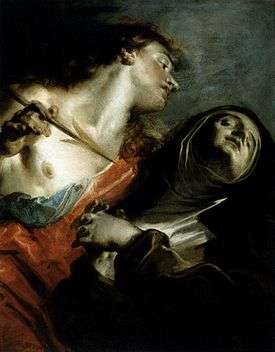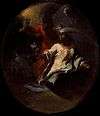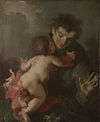Giuseppe Bazzani
Giuseppe Bazzani (23 September 1690 – 17 August 1769) was an Italian painter of the Rococo.
Giuseppe Bazzani | |
|---|---|
 Ectasy of St Theresa | |
| Born | September 23, 1690 |
| Died | August 17, 1769 (aged 78) |
| Nationality | Italian |
| Education | Giovanni Canti |
| Known for | Painting |
| Movement | Baroque |
| Patron(s) | Giacomo Biondi |
Biography
Born in Mantua to a goldsmith, Giovanni Bazzani, early on he apprenticed with the Parmesan painter Giovanni Canti (1653–1715). A fellow pupil was Francesco Maria Raineri. He spent most of his life in Mantua. From 1752, he was faculty, and from 1767, director of the Accademia di Belle Arti of Mantua.
While esconced in a declining provincial city, he absorbed international influences. His loose brushstrokes, fervid often dark emotionalism, and tortured poses, which recall at times later expressionism, display stylistic tendencies more typical of Lombardy. Numerous artists, including Fetti, Bencovich, Rubens, and Magnasco are said to have influenced him, although the number and diversity of the artists suggested hints that he had an idiosyncratic and unique synthesis for his time.
Among his early works are paintings of the Miracles of Pius V, the Conversion of a Heretic and the Healing of a Madwoman (all mid-1720s; Mantua, Museum of the Ducal Palace of Mantua), initially painted for the church of Saint Maurice in Mantua. He painted depictions of the evangelists St. John, St. Mark and St. Luke (all late 1720s) for the parish church of Vasto di Goito. He painted the Baptism, the Ecstasy of St. Aloysius Gonzaga and the Ecstasy of Saints Francis & Anthony (1732) for the parish church of Borgoforte. Seven canvases depicting the Life of Alexander the Great were painted for Giacomo Biondi, one of the artist's early patrons. His altarpiece of St Romuald's Vision, initially painted for the church of San Marco, but now in Diocesan Museum of Mantua,[1] the saint, book in hand, has a dream in which he sees his fellow Benedictine monks ascending to heaven in a clumsy, touching, human parade up a staircase instead of a mystical Jacob's ladder. The painting merges a mixture of mystical vision and stylized empiric observation. The nineteenth-century art historian Carlo D'Arco was unconvinced about this brash new style, and said of Bazzani's work that (he) wanted always to always use a great force of genius ...and most of his works appear as if unperfected sketches and immature conceptions that are drowning and convulsing in mannered styles."[2]
The painter Domenico Conti Bazzani (1740-1815) was his pupil and adopted son, and became a prominent Neoclassical painter in Rome.[3]




_-_Nationalmuseum_-_19157.tif.jpg)

References
| Wikimedia Commons has media related to Giuseppe Bazzani. |
- Wittkower, Rudolf (1993). Pelican History of Art: Art and Architecture Italy, 1600-1750. Penguin Books, Ltd. pp. 478–479.
- Perina, Chiara (1964). Some Unpublished Paintings by Giuseppe Bazzani. The Art Bulletin. pp. 227–231.
- Coddè, Dr. Pasquale (1837). Augmented and written by the Luigi Coddè, PhD. (ed.). Memorie Biografiche, poste in forma di Dizionario die Pittori, Scultori, Architetti, ed Incisori Mantovani. Presso i Fratelli Negretti, Mantua; Digitized by Googlebooks from Oxford University on 16 October 2006. pp. 12–17.
- Web Gallery of Art biography on Bazzani.
- "Archived copy". Archived from the original on 2012-02-04. Retrieved 2012-02-10.CS1 maint: archived copy as title (link) museum website
- Delle arti e degli artefici di Mantova: notizie raccolte ed illustrate con Disegni e con Documenti, Volume 1, by Carlo D'Arco,(1857) Mantua.]
- Encyclopedia Treccani, Dizionario Biografico degli Italiani - Volume 28 (1983), entry by Ksenija Rozman.
Anthology
| Label | Work | Date | Site | Link |
|---|---|---|---|---|
| a. | Via Crucis | San Barnaba, Mantua | ||
| b. | Via Crucis | Parish church, Cavriana | ||
| c. | History of Alexander the Great | c. 1740 | Palazzo d'Arco, Mantua | |
| d. | Baptism of Christ | c. 1732 | Parish church, Borgoforte | |
| e. | Ecstasy of Saint Aloysius Gonzaga | c. 1729 | Parish church, Borgoforte | |
| f. | Baptism of Christ | c. 1737 | San Giovanni del Dosso, Mantua | |
| g. | Delivery of the Keys to St. Peter | 1739 | Parish Church, Goito | |
| h. | Sermon of the Baptist | c. 1740 | Parish church, Gazoldo degli Ippoliti | |
| i. | Doubting Thomas | c. 1742 | Private collection | |
| j. | Madonna with St. Clare & Annunciation | 1751-52 | Parish church, Revere | |
| k. | Miracles of Pius V | 1752 | San Maurizio, Mantua | |
| l. | Ovals in private collections | Mantua and Bologna | ||
| m. | Ovals of the Miracle of the Rosary | Originally, parish church of Cavriana | ||
| n. | Canvases | Santa Maria della Carita, Mantua | ||
| o. | Ovals for the ceiling of St. Barnaba | c. 1768 | San Paolo, Mantua | |
| p. | St. Margaret of Cortona | 1764 | Prampolini-Tirelli collection | |
| q. | Saint Anthony of Padua with the Infant Christ | c. 1745 | National Gallery, London | |
| r. | Pieta with the Magdalen | c. 1750 | Cleveland Museum of Art, Ohio, USA | |
| s. | Incredulity of St. Thomas | 1730 | Tucson Museum of Art, Arizona, USA | |
| t. | Departure of Prodigal Son | 1750 | Nelson-Atkins Museum, Kansas City, USA | |
| u. | The Tribute Money | MacKenzie Art Gallery, Saskatchewan | ||
| v. | The Tribute Money | 1742 | San Diego Museum of Art, California, USA | |
| w. | Rest in Flight to Egypt | Accademia, Venice | ||
| x. | The Daughter of Jephthah | Louvre, Paris | ||
| y. | The walk to Mount Calvary | Louvre, Paris | ||
| z. | Deposition from the Cross | |||
| aa. | Ecstasy of St Theresa | 1745 | ||
| bb. | Agony of Christ in the Garden | Uffizi Gallery, Florence | ||
| bb. | Santa Margarita da Cortona | 1740 | Galleria della Fondazione Banca Agricola Mantovana, Mantua | |
| cc. | St. Longinus, Sant'Andrea, Sant'Elena with the relice of the precious blood | 1740 | ibid |